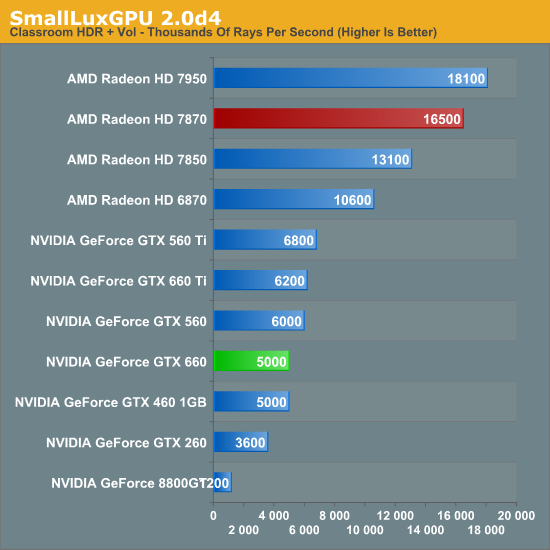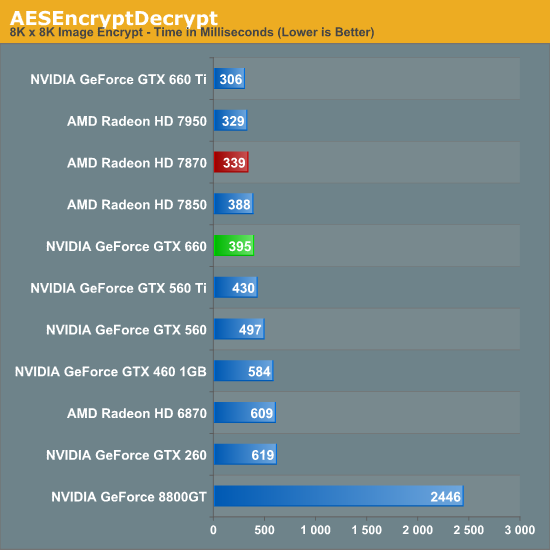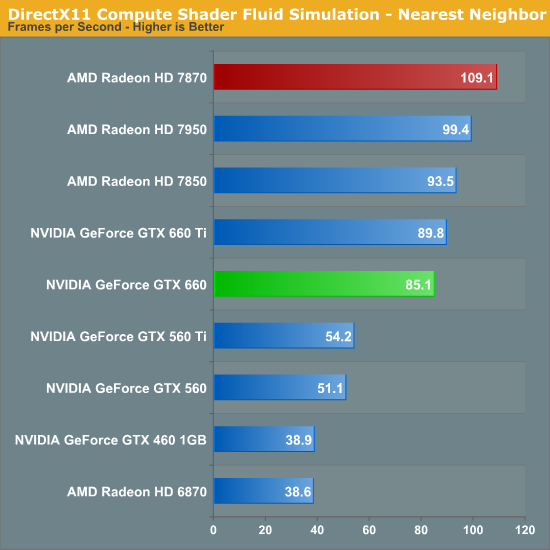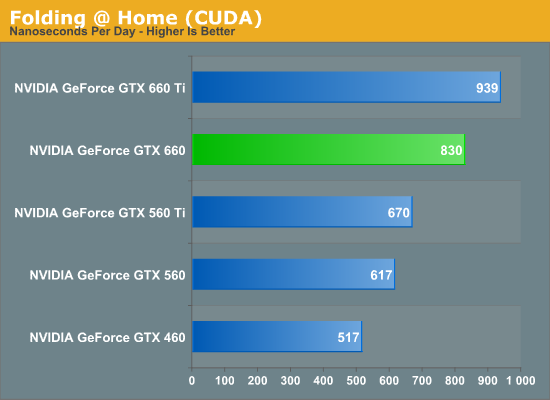The NVIDIA GeForce GTX 660 Review: GK106 Fills Out The Kepler Family
by Ryan Smith on September 13, 2012 9:00 AM ESTCompute Performance
As always our final set of real-world benchmarks is composed of a look at compute performance. As we have seen with GTX 680 and GTX 670, Kepler appears to be significantly less balanced between rendering and compute performance than GF110 or GF114 were, and as a result compute performance suffers. Further compounding this is the fact that GK106 only has 5 SMXes versus the 8 SMXes of GK104, which will likely further depress compute performance.
Our first compute benchmark comes from Civilization V, which uses DirectCompute to decompress textures on the fly. Civ V includes a sub-benchmark that exclusively tests the speed of their texture decompression algorithm by repeatedly decompressing the textures required for one of the game’s leader scenes. Note that this is a DX11 DirectCompute benchmark.

It’s interesting then that despite the obvious difference between the GTX 660 and GTX 660 Ti in theoretical compute performance, the GTX 660 actually beats the GTX 660 Ti here. Despite being a compute benchmark, Civlization V’s texture decompression benchmark is more sensitive to memory bandwidth and cache performance than it is shader performance, giving us the results we see above. Given the GTX 660 Ti’s poor showing in this benchmark this is a good thing for NVIDIA since this means they don’t fall any farther behind. Still, the GTX 660 is effectively tied with the 7850 and well behind the 7870.
Our next benchmark is SmallLuxGPU, the GPU ray tracing branch of the open source LuxRender renderer. We’re now using a development build from the version 2.0 branch, and we’ve moved on to a more complex scene that hopefully will provide a greater challenge to our GPUs.

SmallLuxGPU sees us shift towards an emphasis on pure compute performance, which of course is going to be GTX 660’s weak point here. Over 2 years after the launch of the GTX 460 and SLG performance has gone exactly nowhere, with the GTX 460 and GTX 660 turning in the same exact scores. Thank goodness the 8800GT is terrible at this benchmark, otherwise the GTX 660 would be in particularly bad shape.
It goes without saying that with the GTX 660’s poor compute performance here, the 7800 series is well in the lead. The 7870 more than trebles the GTX 660’s performance, an indisputable victory if there ever was one.
For our next benchmark we’re looking at AESEncryptDecrypt, an OpenCL AES encryption routine that AES encrypts/decrypts an 8K x 8K pixel square image file. The results of this benchmark are the average time to encrypt the image over a number of iterations of the AES cypher.

Our AES benchmark was one of the few compute benchmarks where the GTX 660 Ti had any kind of lead, but the significant loss of compute resources has erased that for the GTX 660. At 395ms it’s a hair slower than the 7850, never mind the 7870.
For our next benchmark we’re looking at AESEncryptDecrypt, an OpenCL AES encryption routine that AES encrypts/decrypts an 8K x 8K pixel square image file. The results of this benchmark are the average time to encrypt the image over a number of iterations of the AES cypher.

The fluid simulation is another benchmark that includes a stronger mix of memory bandwidth and cache rather than being purely dependent on compute resources. As a result the GTX 660 still trails the GTX 660 Ti, but by a great amount. Even so, the GTX 660 is no match for the 7800 series.
Finally, we’re adding one last benchmark to our compute run. NVIDIA and the Folding@Home group have sent over a benchmarkable version of the client with preliminary optimizations for Kepler. Folding@Home and similar initiatives are still one of the most popular consumer compute workloads, so it’s something NVIDIA wants their GPUs to do well at.

As we’ve seen previously with GK104, this is one of the few compute benchmarks that shows any kind of significant performance advantage for Little Kepler compared to Little Fermi. GTX 660 drops by 12% compared to GTX 660 Ti, but this is still good enough for a 60% performance advantage over GTX 460.










147 Comments
View All Comments
chrnochime - Thursday, September 13, 2012 - link
You mean that they spun the results in NV's favor when the 670 came out, and then again in AMD's favor when comparing OC results from 7950 against 660TI OC and 670 OC?chizow - Thursday, September 13, 2012 - link
Is AMD going to issue rebates for the 7870? $150 price drop in 4 months is pretty sad beans for all the AMD early adopters.RussianSensation - Thursday, September 13, 2012 - link
No, because if you want the latest tech on latest 28nm, you understand you are paying a premium for it. If not, you sit out for 6-7 months and wait for more price drops. This is how it always worked. I am sure early AMD adopters don't care since their cards already paid for most of their cost with bitcoin mining on the side and they have enjoyed a cool and efficient card for 7 months. How are your 680s doing that you dropped $1k on?Care to remind everyone that GTX280 launched at $649 on June 16, 2008, dropped $150 1 month immediately when 4870 launched and then 9.5 months later AMD delivered a $269 HD4890 that offered similar performance.
I guess in that generation the early adopter lost $380 by going with the 280 in just 9.5 months but you failed to mention that's how it works in the GPU industry.
chizow - Thursday, September 13, 2012 - link
Except we already knew the 7870 wasn't worth the asking price when it was released, so the natural response would've been to wait by those who already knew price drops were imminent on grossly inflated 28nm parts.And I guess you already forgot, Nvidia did right by its early adopting customers by issuing $100-$150 rebates to those who bought a GTX 260 or 280 before the price drops, which is why I asked. Same reason I asked if AMD was going to do the same if and when Nvidia adjusted the pricing landscape with Kepler to force cuts across the board for AMD's ridiculous pricing structure. So again, where are AMD's rebates given every 28nm part they released is worth roughly 30-40% less than original MSRP? That's more than even your referenced drops on the GTX 260/280.
4890 was nothing special, Nvidia released an equivalent GTX 275 for similar price and those prices were due largely to price wars in the midst of a massive global recession.
As for my $1K GTX 680s, they don't exist because I wouldn't pay that much for such a small increase in generational performance on a midrange ASIC, I paid $660 for 2x GTX 670 on 680 PCBs instead which is probably still a bit more than I think they are worth, but I figure after the 2x Borderlands promos they are much closer to the $300 price point a 2nd tier GK104 SKU should have been sold at anyways. :D
rarson - Friday, September 14, 2012 - link
"Except we already knew the 7870 wasn't worth the asking price when it was released"So the people who "knew" this weren't buying it anyway, and hence do not need a rebate. You really should read what you write before posting your comment.
Here's how technology works, dude: new technology is expensive. As time goes on, it becomes cheaper as more people start adopting it. The 7870 really was worth the price when it came out (no shit, it really was). You can figure this out by seeing that people actually went and bought them. Supply was constrained and the process was very expensive (more so than previous process shrinks) so even just getting the wafers allocated was tougher than before. On top of that, AMD had to adjust their pricing to deal with the constrained supply. Price it too low, and whatever stock that you have sells out too quickly and you sit for months with no stock on the shelf, selling nothing (just ask Nvidia).
I know, I know, you can't grasp basic economics. I'm wasting my breath. Maybe once you move out of the basement you'll figure out how the real world works.
chizow - Friday, September 14, 2012 - link
Yeah it was a rhetorical question, I know AMD isn't issuing rebates, they don't have the money to return they'd just be borrowing more from Abu Dhabi to cut that check that might very well bounce.As for how technology works, you once again demonstrate how little you know about the industry. Prices drop, like the GTX 580/570 and 6970/6950 that held their prices for a good full 20 months before the launch of 28nm parts? And even after the launch of 28nm, they still held their prices because there was no incentive or need to drop in price based on relative price and performance?
You have no idea what you're talking about, stop typing. Parts lose their value and drop in price when a new part forces that change. Usually this happens when a new generation of product or a new process/fabrication node forces the change by introducing a dramatic increase in price:performance. In this case, the prices drops are being forced by products that are the *SAME* process and relative generation (from Nvidia).
What this *SHOULD* tell you is that the 28nm offerings from AMD were grossly overpriced and offered FAR less improvement for the asking price, but these simple concepts obviously escape you.
Galidou - Saturday, September 15, 2012 - link
660$ for 2 gtx 670 on 680 pcbs, you got engineer samples? I've been looking on ebay for USED 670 and the best price one ended was 355$ with shipping and that was without the borderlands 2 coupon. I've seen some reference cards going down to 344$ before taxes and after 20$ mail in rebate(around 380$ shipped) but they were FAR from 680 PCBs.I'd really like to see those 670's at 330$ with 680 PCB's, would really like.....
One comment about the rebate on the gtx 280, it's quite different from now. The 549$ radeon 7970 lost to a 499$ gtx 680 3 months after it's launch.
The 650$ gtx 280 was on average 10% better and sometimes 10% worse than the 300$ radeon 4870 one month after it's launch...
chizow - Saturday, September 15, 2012 - link
Hi Galidou, you're not here to defend AMD's launch prices again too are you?670 on 680 PCBs are quite commonplace, maybe you've heard of the EVGA FTW versions? Galaxy has a similar one with their GC parts, no engineering samples needed:
http://forums.anandtech.com/showthread.php?t=22660...
http://www.newegg.com/Product/Product.aspx?Item=N8...
Please feel free to check the reviews on Newegg link, you will see I'm a verified owner. ;)
As for the GTX 280, once again more revisionist history from the usual suspects. GTX 280 was closer to 15-20% faster especially at high resolutions with AA due to the 1GB VRAM compared to the 4870's 512MB. The gap widens even further if you look at later reviews.
http://www.computerbase.de/artikel/grafikkarten/20...
Only after the 1GB 4870 and 4890 releases months later did this change so the price difference even after the $150 price cut to $500 was still justifiable. I still have a GTX 280 as a backup card and it still runs modern games great, a 512MB 4870 would barely be able to handle the default frame buffer....
Secondly, GTX 280's asking price was reasonable compared to last-gen parts, unlike AMD's 28nm parts, as it offered 2x the performance of the 8800/9800GTX, more performance than the 9800GX2 or 3870X2, and almost tripled the performance of AMD's fastest single GPU, the 3870. What Nvidia did not account for was both AMD's return to competitiveness with the RV770 *AND* their massive undercut on pricing simultaneously.
Lastly, of course, is Nvidia actually did right by their customers by issuing those rebates, which is just good business to ensure they took care of their most enthusiastic customers. Certainly more than we can say for AMD though. AMD may have made some short-term profit, but at what cost? They certainly have more than a few fans who are going to be outraged by the massive cuts so soon after launch.
Galidou - Saturday, September 15, 2012 - link
I just removed the 4870 512mb I had and it still runs perfectly but my wife used it on a 1680*1050 monitor. The 280 took advantage at 2560*1600, but you can imagine it was mainly for benchmark purposes. Not a lot of people do use this resolution NOW so imagine 4 years ago... let's say >0,05% back in 2008(most of them being artists and not gamers), considering the cost of one of those monitors... yep you guessed it, about the price of 2 gtx 280 at launch, for ONE monitor.... The price of my whole computer with the 4870 back in 2008...''Secondly, GTX 280's asking price was reasonable compared to last-gen parts, unlike AMD's 28nm parts, as it offered 2x the performance of the 8800/9800GTX''
When AMD fanboys said the 7970 was priced rightly compared to last gen parts(which it was, there was no bargain for sure but it was 40% higher price for 70% more perf) Nvidia fanboys said: You gotta be freaking kidding me, are you blind, ffs remove your red glasses and wake up''.
''Hi Galidou, you're not here to defend AMD's launch prices again too are you?''
Not necessarily but it seems you are here to attack them again. A 550$ card loses in 65% of the games to a 500$ card 3 months after it's launch(radeon 7970 vs gtx 680)....a 650$ card is 10% faster than a 300$ card in 60% of the games one month after it's launch(gtx 280 vs 4870). My reflections above seemed logical to me, I guess life is a question of perception.
Galidou - Saturday, September 15, 2012 - link
I think there's one thing we should say about pricing mistakes and rebate. A gamer buying an i7 980x 1 week prior to the sandy bridge launch, and I know it happened... poor them...Nice link on the German website, you must of looked a lot of websites to find a 20% advantage on average for a gtx 280 because tom hardware, techpowerup and anandtech shows it average 10% faster but nice finding you got there. If only I could read German. And we both know the websites I named above are certainly more highly regarded than computerbase.de..........
And good job, because I'm really looking forward to change the gtx 660 ti I got for my wife for a gtx 670 but the best I could get to is either 355$ USED(an auction, not a buy it now) on ebay or 344$ before taxes and after mail in rebate(hate those I'm usually not even using them because they use your information to harass your life). But I guess it's possible to find them at 330$ after mail in rebate and before taxes but in the end it's closer to the 400$ mark than the 300$ mark.